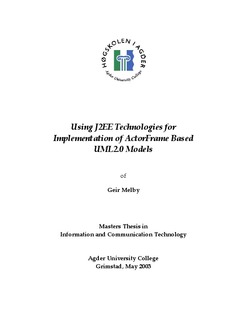| dc.contributor.author | Melby, Geir | |
| dc.date.accessioned | 2007-07-10T07:40:23Z | |
| dc.date.issued | 2003 | |
| dc.identifier.uri | http://hdl.handle.net/11250/137352 | |
| dc.description | Masteroppgave i informasjons- og kommunikasjonsteknologi 2003 - Høgskolen i Agder, Grimstad | en |
| dc.description.abstract | Ericsson has developed a prototype of a Java framework called ActorFrame, for
development and execution of services. The services will be deployed in networks
where current Telecommunication and Internet has merged into an open service
oriented network. The services are modeled using UML 2.0 concepts for concurrent
state machines communicating asynchronously through message passing.
ActorFrame has been used in development of prototype services deployed in real
networks as part of the AVANTEL research project. The background for this thesis
study is that Ericsson wants to move ActorFrame to a J2EE technology.
This report gives an introduction to the core technologies of interest: J2EE,
ActorFrame and UML2.0. J2EE is a set of API’s where the component technology
EJB, name server JNDI and the message system JMS are the most central
technologies. A new version of UML, called UML2.0, has been worked out by a
consortium where Ericsson has been an active partner. The basic concepts of UML2.0
that support the concept-oriented approach in ActorFrame based models, is
presented.
There exist different conceptual approaches to the problem of mapping platform
independent models to concrete implementations. The approach taken in this thesis
is a concept-oriented approach where domain specific concepts are used in the
modeling of services. The concepts are defined as stereotypes in UML and a specific
UML profile for ServiceFrame are proposed as part of this work.
The principle mapping of these concepts to the J2EE technologies are discussed,
which forms a background for the design of a prototype of a framework for EJB. The
framework is used in implementation of services by extending the classes defined in
the framework. The solution was validated through implementation of an example
that was run on a J2EE application server.
The main conclusion from this thesis work is that ActorFrame models can be
implemented on J2EE application servers in a beneficial way. The platform supports
asynchronous communication and it is possible to combine this communication style
with implementation of persistent state machines.
The J2EE platform gives additional benefits compared to the current implementation
of ActorFrame such as integration of Web services, increased management support,
flexible distributions of actors, scalable application platforms, and transaction
services.
The thesis work has also shown that there exists many mapping solutions and not all
mapping issues have been elaborated. However this work should form a basis for
further work with frameworks for service development and execution. | en |
| dc.format.extent | 1401918 bytes | |
| dc.format.mimetype | application/pdf | |
| dc.language.iso | eng | en |
| dc.publisher | Høgskolen i Agder | |
| dc.publisher | Agder University College | |
| dc.subject.classification | IKT590 | |
| dc.title | Using J2EE technologies for implementation of ActorFrame based UML 2.0 models | en |
| dc.type | Master thesis | en |
| dc.subject.nsi | VDP::Matematikk og naturvitenskap: 400::Informasjons- og kommunikasjonsvitenskap: 420::Kommunikasjon og distribuerte systemer: 423 | |
| dc.subject.nsi | VDP::Matematikk og naturvitenskap: 400::Informasjons- og kommunikasjonsvitenskap: 420::Systemutvikling og -arbeid: 426 | |
